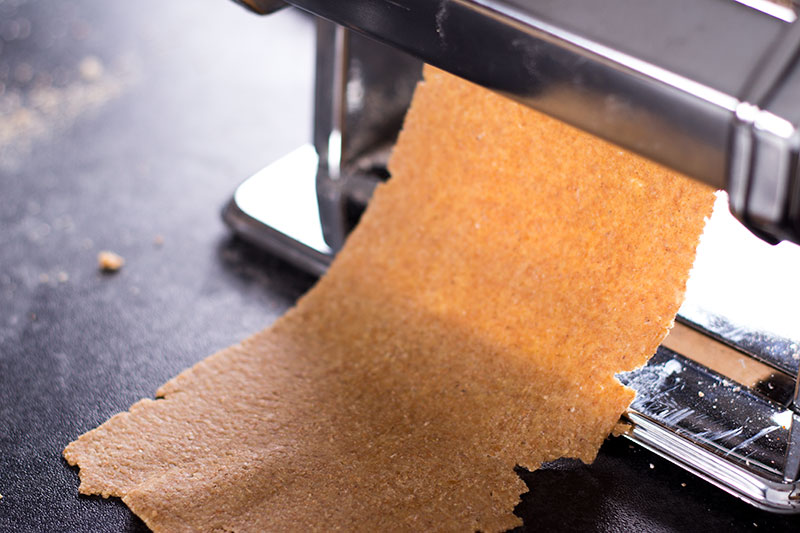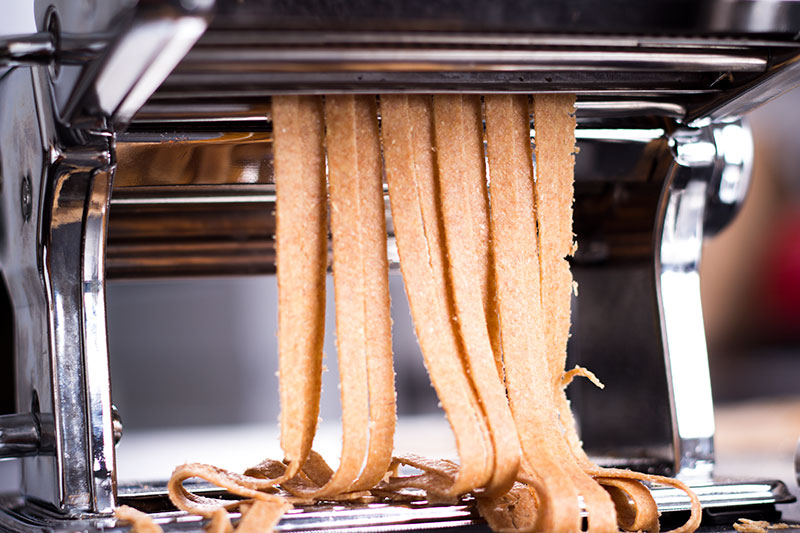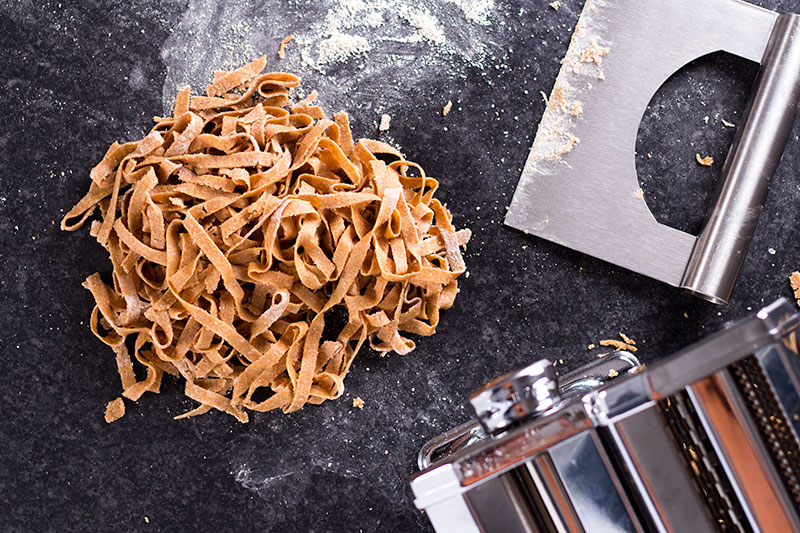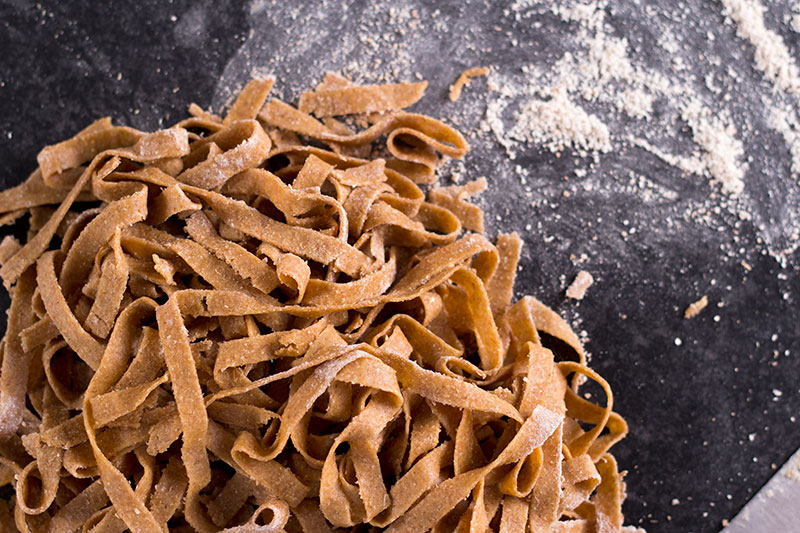I’ve made homemade pasta previously, from silky whisps of fine tagliatelle to carefully manipulated, pillowy ravioli. It’s one of those things that’s a domestic indulgence, because shop bought, dried pasta is so good and easy to cook that it’s hard to justify the time and effort required in making your own. But, in the true spirit of indulgence, it is also incredibly satisfying to make this simple ingredient and if we always chose the quickest, easiest, ready-prepared method, we might all turn into mindless zombies.

Despite this previous experience of homemade pasta and the fact that pasta contains so few ingredients, it ended up quite a tricky recipe to develop. Balls of pasta, eggs shells and flour very nearly adorned the kitchen window as I tried to rationalise dryness, stickiness, toughness and splitting, so that I could explain it to you. The end result really is quite a rough (rustic?) pasta which is lovely and tender, with a great flavour, however the use of wholemeal spelt seemed to add a slightly different dimension to creating the pasta, which I can put down to a few factors.


The most nuanced part of this procedure is making sure the pasta is wet enough, as it had a tendency to crack very easily if dry, or possesses similar adhesive qualities to superglue if too wet. Below are a few fundamental points about making wholemeal spelt pasta, so you’re clear on what’s happening and why.
There’s no knead
There are many sites which advocate kneading spelt pasta for several minutes, however I find this completely unnecessary. In general, spelt doesn’t require as much kneading as regular wheat, so I don’t see why there’s any exception here.
The finer things in life
Large pieces of bran in spelt flour, or the ‘rough bits’ as you might know them, are best sieved out as a precaution. When you sieve wholegrain spelt, these are the bits which don’t quite want to go through. No doubt you can make spelt pasta with them still in, but pasta comes together more easily with finely ground flour. Spelt flour often only comes in one grade, whereas traditional wheat flour comes in all sorts of grades, including the ultra fine ‘Tipo 00’ which helps make smooth, velvety pasta. If you are able to select a finer grade of spelt flour, or are able to grind it yourself, then I would advise going for the finest option possible.
Sticky business
In many parts of Italy there are regional variations on how to make pasta, which adjust the quantities of egg, egg yolk, water or oil. You might also get different results each time you make pasta, which might be down to the size of your eggs, the humidity, the grind of your flour, or numerous other nuanced factors. I’ve worked up a recipe that accounts for this and allows you to simply adjust as you go. Spelt becomes irritatingly sticky when it has moisture added to it, due to the makeup of it’s protein. The level of adhesion between dough and hand is quite incredible sometimes, especially when you’re trying to keep the dough on the worktop. However, don’t let this put you off, as you need to work through this stage to reach the moist, almost-tacky stage which you need for the pasta. It’s at this point that you need to work on adding either flour or water to tweak that consistency.
The pasta in the photos is probably a hint on the dry side of things, however it still worked and tasted lovely. You could also apply this recipe to refined, or white spelt flour, again bearing in mind that this change might mean a slight tweak of liquid or flour is required.


Wholemeal spelt pasta
By Gavin Wren
Serves 2-4
Uses a pasta machine
PDF recipe card to download or print
Ingredients
200g wholemeal spelt flour
A pinch of salt
2 large eggs
2 teaspoons olive oil
Water, as required
Directions
Crack your eggs into a cup or bowl, add the olive oil and gently whisk with a fork until well mixed.
Clean and dry your worktop, then put your flour onto it in a pile. Make a well in the middle of the flour, easily large enough to hold all of the egg mixture. Pour the egg mixture into the well.
Using your fork, gently whisk the egg mixture, bringing bits of flour into the mix from the edges each time you go around. Continue doing this until it’s combined as much as possible with a fork, then start using your hand to bring it all together.
It’s at this point that the mixture will be ridiculously sticky. It will feel like there is more of it stuck to your hand than there is on the worktop. Mix with one hand and keep the other clean to hold a fork or bench scraper, so that you can regularly scrape down your hand and surface, to bring all the errant bits together.
If you keep mixing through this stage, it should ease into a manageable, smooth lump. If it’s all mixed into a ball but won’t go past being ridiculously sticky, throw on a pinch of flour and mix a bit more. If you find the mixture is cracking, dry or crumbly, then add a teaspoon of water and mix a bit more. Knead it just a few times.
Once you have a smooth, soft ball, wrap it in cling film and leave to rest at room temperature for at least 15 minutes and up to a few hours.
The next stage is to roll it out, which you can do with a rolling pin or use a pasta machine. The pasta machine allows you to achieve a very uniform thickness easily, which would be much more tricky by hand. Starting with the thickest setting, roll the pasta through the machine’s rollers. Move down a thickness and roll again. Repeat until at your desired thickness, but I would suggest not going to the thinnest setting with spelt as the pasta becomes delicate and might break.
Now, your pasta is ready to use in sheets or ravioli, or you can run it through the other side of your machine to cut into tagliatelle etc. If you want to dry it, hang the finished pasta over a wooden spoon, or get a pasta drying rack like this to hang it on, until it’s hardened.
To cook your pasta, bring a large pan of salted water to the boil and add the pasta, stirring occasionally. Boil the pasta for about 4 minutes then drain and serve.

